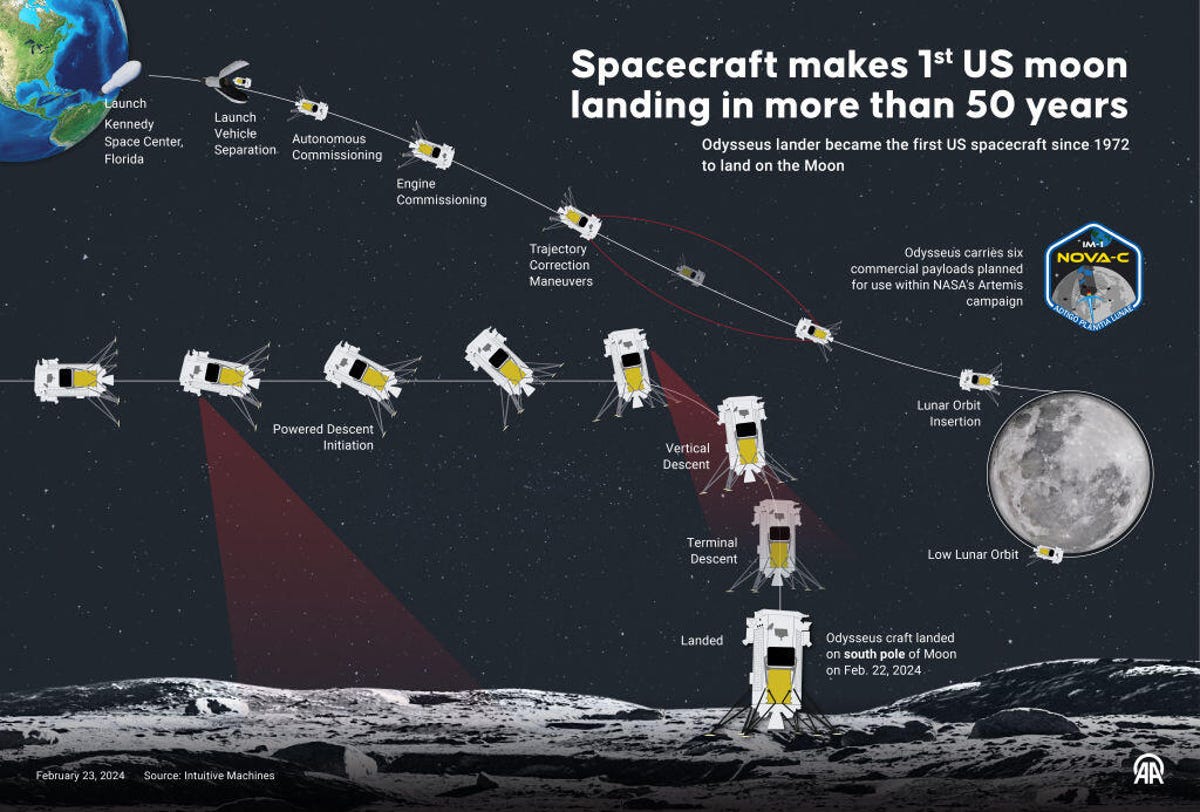Goodbye, Odie. On Thursday, Houston-based space-exploration company Intuitive Machines bade farewell to Odysseus, the lunar lander that took the US to the moon for the first time in more than 50 years. The lander had been there for a week and will remain on the moon’s surface, inoperable but remembered as a historic achievement in the annals of lunar exploration.
“Before its power was depleted, Odysseus completed a fitting farewell transmission,” the company wrote in a tweet shared on Thursday. “Received today, this image from February 22nd showcases the crescent Earth in the backdrop, a subtle reminder of humanity’s presence in the universe. Goodnight, Odie. We hope to hear from you.”
The image tweeted out by Intuitive Machines. Look close and you can see the Earth. (Click to enlarge.)
Intuitive Machines via X/TwitterIntuitive Machines successfully landed Odysseus on the moon’s surface Feb. 22, after a seven-day space trek by the craft. It’s the first time an American vehicle has been on the surface of the moon since Apollo 17 in 1972. But unlike the Apollo missions, which were entirely operated by NASA, this time the space agency hired the private company to send a lander to the moon.
The United States is the only country to ever put humans on the moon, but its focus shifted away from the lunar surface in the 1970s. In recent years, though, NASA has been planning a return, through its Artemis mission, which right now is scheduled to put boots back on the moon no earlier than September 2026 (several years after the original target date). Meanwhile, the space agency has been working with private companies like Elon Musk’s SpaceX and Jeff Bezos’ Blue Horizon on a variety of missions, including through its Commercial Lunar Payload Services initiative. The Odysseus mission was under CLPS auspices.
Here’s what to know.

The Odysseus lander became the first US spacecraft to land on the Moon since 1972.
Odysseus moon mission
The Odysseus mission was endorsed by NASA to collect scientific data from the moon’s surface. The lander, known internally as the Nova-C lander — and fondly to Intuitive employees as “Odie” — is about the size of a phone booth. It landed in the South Pole region of the moon called Malapert A at 6:24 p.m. ET on Feb. 22.
Odie was equipped with a host of instruments to investigate the lunar surface and radio waves and send photos back to the US, NASA said. The lander also featured a retroflector array that helped NASA identify its location and keep track of where to send other autonomous vehicles during future missions.
The launch and landing part of the mission lasted seven days, but it was fraught with drama after the Intuitive Machines team discovered that the lander’s range-finding system was inoperable and that the team needed to recode Odysseus to use a different range-finding system to pull off a safe landing. What’s worse, the team found that Odysseus was descending at a rate much faster than expected, increasing the likelihood of a crash. Luckily, that didn’t happen.
What to know about Intuitive Machines
Intuitive Machines is the first benefactor of the NASA Commercial Lunar Payload Services program, which the agency started in 2018. NASA researched whether to build and send a lunar lander of its own to the moon. But the space agency determined it would be cheaper, with potentially greater chances of success, to instead pay commercial companies to handle the task.
NASA paid Intuitive Machines $118 million to send Odysseus to the moon. The agency hoped to learn more about the lunar surface and where to eventually send humans back to the moon.
About the Odysseus technology
Odysseus carried several instruments for learning more about the moon and space.
En route to the moon, NASA instruments aboard the craft measured its consumption of cryogenic fuel, and while Odysseus was touching down, another instrument tested the dust the lander kicked up.
Once Odysseus was on the moon, additional technologies were used to evaluate the lunar surface. One, called the Lunar Node 1 Demonstrator, focused on autonomous navigation to show how future landers could traverse the surface. A Laser Retroflector Array conducted range-finding and distance measurements. And a radio wave instrument analyzed the moon’s surface radio waves to determine how’d they’d affect the work of humans conducting science there. Also, four cameras captured images of the lander’s environment.
Tipsy Odysseus
Intuitive Machines confirmed that Odysseus landed off-kilter after it apparently got one of its feet caught on something. The company now believes the lander is either tilted on a rock or lying on its side on the slope of a hill.
Despite the less-than-ideal positioning, Intuitive Machines was able to communicate with Odysseus and its sensors remained operational.
Short life span
Though Odysseus spent just a week on the lunar surface, that’s all it gets. The lander was slated to be operational for only nine to 10 days. After that, Intuitive Machines knew the sun would set on the landing site, and Odysseus’ radios and batteries can’t survive the extremely cold lunar nights.
What’s next
The Odysseus lander mission is just the first in a string of NASA missions that aim at eventually getting astronauts back to the moon. Like Odysseus, future landers will explore the lunar surface, scout ideal locations for landing astronauts, and perform scientific research.
For its part, Intuitive Machines isn’t done on the moon. The Odysseus mission may be over, but the company is already working on two other moon lander missions, slated to launch later this year.

